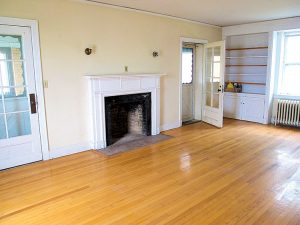By Liz Sheehan
SANDY HOOK- After attempts reaching back to 1999, The National Park Service (NPS) announced on May 9 that it has finally issued the first lease on a building in Officers Row in historic Fort Hancock.
The lease was issued to Brian Samuelson and Joseph Dorsey.
Daphne Yun, acting public affairs officer, said the details of the 60-year lease were not available.
Samuelson, of Atlantic Highlands, said that work was being done on the two-family house, known as building 21, which faces Sandy Hook Bay. The goal is to get one section, which has three bedrooms, ready for occupancy this summer.
Samuelson said Tuesday that the building would be rented out for monthly or seasonal use, or for holiday vacations, such as Christmas or Thanksgiving. This is consistent with his application, which said the house would be used as “a family residence in the off-season and a weekly, monthly or seasonal rental during the summer months.”
Samuelson, an airplane pilot, said that “everything is up in the air,” when asked if he would be using the house as a residence.
The application also said that Samuelson was interested in rehabilitating “between one and five” other buildings on Officers Row.
When asked if he would be doing other renovations of buildings at the fort, he replied that he would handle “one crisis at a time,” but “I’m keeping an open mind.”
The announcement from the park service of the lease quoted Samuelson and Dorsey as saying, “We hope to eventually make accommodations for the general public for summer rentals” which plan to advertise with a website.
The park service’s first attempt to lease the buildings was in 1999, when a 60-year lease was given to Rumson developer James Wassel to renovate and commercially develop more than 36 buildings at the fort. The park service said it did not have the funds to restore the buildings covered in the lease. The proposal was met by strong opposition from local residents who formed Save Sandy Hook, a grassroots organization, to oppose the plan.
The Wassell lease was cancelled in 2009, when the developer, after a series of extensions, was not able to show he had the financial means to rehabilitate the buildings.
In 2012, a notice was put in the Federal Register that an advisory committee would be appointed by the Secretary of the Interior with White House Approval to form plans for Ft. Hancock’s future. The committee, named the Fort Hancock 21st Century Committee, has 23 members, including local elected officials.

Last December, a spokesperson for the park service said it was in negotiations with potential lessees for three of the fort buildings.
According to the park service website, those leasing the buildings have to pay to renovate the structures, following the standards of historic preservation properties. The proposed rent would be offset by the cost of renovation.
The terms of the lease would be based on fair market value, John Warren, External Affairs Officer at the NPS, said.
According to the NPS the Fort Hancock has been a major factor in the defense of the New York harbor since colonial days. It served as a proving ground and was renamed in 1895 and deactivated in 1974.














